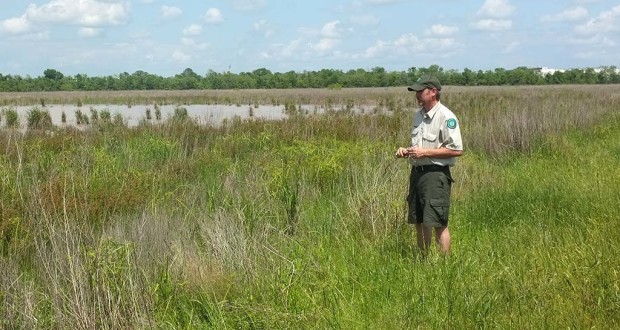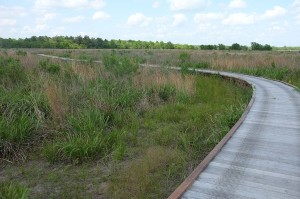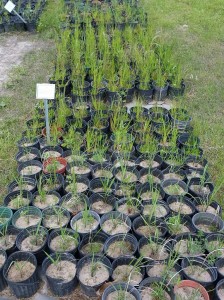NOTE: This is the second of a two-part series on the restoration of the prairie at Sheldon Lake State Park. The first post explains how biologist Andrew Sipocz and his team revealed the original contours of the prairie.
There’s a battlefield in northeast Houston.The enemy is a ragtag band of invasive grasses and noxious weeds that has overwhelmed the native grasses that once dominated Sheldon Lake State Park‘s prairie wetland.
Over the last decade, the Texas Parks & Wildlife staff and its partners have pulled them up and mowed them down. They’ve doused them with herbicides and burned them to the ground. And still, they keep coming.
It’s a war of attrition measured in years. Slowly, though, the native grasses and plants are grabbing a foothold. In time, they’ll spread throughout the marshes and small ponds of the park, bringing with them more of the birds, frogs and other wildlife that call the Texas wet prairie home.
• Register online
• Call: 281.456.2800, ext. 225 or ext. 230
• Email: tom.olson@tpwd.texas.gov or laura.babcock@tpwd.texas.gov
When I visited the park last summer I could see a subtle difference between the older and newer areas of the restoration. The vegetation in the oldest restoration looks wilder and less uniform. The grasses are taller because they no longer have to be constantly beaten back. Frogs croaked in the marshes, and a Northern Harrier swooped over the grasstops in search of prey.
“We’re trying to recreate in five years what took nature several hundred years to make,” said Kelly Norrid, natural resources specialist at the park.
The first project, Phase I, began about 10 years ago. The last one, Phase IV, is just getting under way.
You can see the “new” prairie stretching out from the park’s towering viewing deck or stroll the newly opened boardwalk that winds through the waving grasses.
Invasive grasses have some peculiar advantages over their native cousins. Their seeds will sprout even on barren ground, and they grow quickly, casting a smothering shadow over the struggling natives. And most importantly, they don’t have the diseases and predatory insects that plagued them in their original home. So, they multiply. And multiply. And multiply. A large deeprooted sedge produces as many as 1 million seeds a year.
“We mow them in late spring, and that knocks them back,” said Norrid. “But then they grow back with multiple stems. We cut them again, and they grow back. And then we hit them again after pollination in late summer or early fall.”
The goal isn’t simply to keep the invasive grasses from growing but to keep them from dropping seeds – thinning the population over time with effective birth control. If the grass is thick enough and the conditions are right, they’ll set the prairie on fire to give it a chance to start over.
Not all these unwanted grasses stormed the prairies on their own; some of them were invited in – as food for grazing livestock or for erosion control along the state’s highways. When cultivation of rice, soybeans and other crops exposed bare soil, these invasive grasses quickly staked their claim to the disturbed ground – one of the reasons they’re often called “pioneers”. Some “noxious but native” plants are troublesome, too, such as ragweed or sump weed.
The most aggressive of the park’s unwanted grasses are vaseygrass and deeprooted sedge, both of which are particularly prolific. Last year, the park declared war on vaseygrass, taking it from as much as 90% of the plant species in surveys of some areas to as low as 5%. This year, deeprooted sedge is Public Enemy No. 1.
In battling the invasive grasses, the park makes a bit of a deal with the devil.
“We don’t like using herbicides,” said Norrid with a wince. “But … in some cases, it’s the only way to get the job done.” They persist in the soil for months and can be harmful to the marsh’s aquatic life if not managed carefully.
Routing the invasive grasses, though, is only part of the story.
At the edge of the prairie lie rows and rows of small pots, each with a few flimsy brown stems. They look more like an abandoned nursery than the promise of a new prairie.
Over the years, an army of Sheldon Lake volunteers has scoured the nearby countryside for these clumps of switchgrass, gammagrass, big and little bluestem, inland sea oats and other native Texas grasses. They dig them up, separate them into these small pots and, after they’re established, thrust them into ground in place of the vanquished invasive grasses. It’s a messy and muddy business. Norrid himself once worked as a park volunteer before joining the staff.
The park staff also collects native grass seed and banks it in cold storage. To give the natives a leg up, they’ll scatter it on ground they’ve recently cut back or burned. They limit their seed-gathering to within about 20 miles to ensure it is genetically compatible with the local ecosystem.
Earlier this year, as spring got under way and summer loomed, the grays and browns of the winter prairie gave way to a canvas of green, highlighted here and there with bright flowers. But already, in one corner of the prairie, new clumps of vaseygrass defiantly lifted their shaggy heads.



You must be logged in to post a comment.